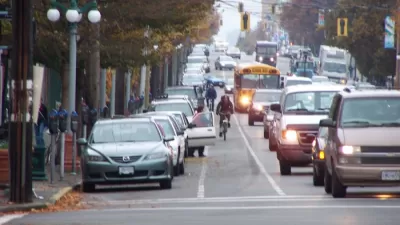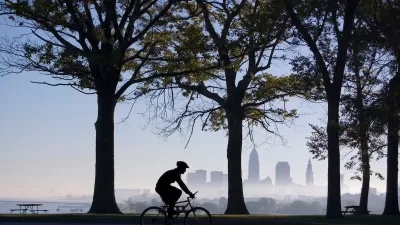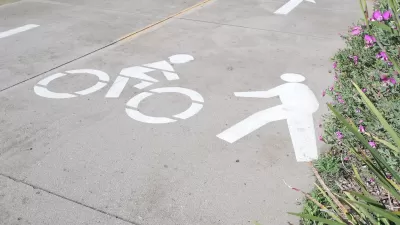The curious case of Cleveland's new "buffered" bike lanes. The question: Why are the buffers placed between the bike lane and the curb?
"Cleveland is finally installing buffered bike lanes along some major streets, but with the buffer between the bike lane and the curb, not between the bike lane and traffic," reports Angie Schmitt.
Schmitt, along with blogger Marc Lefkowitz, have been digging into the configuration to discover why the buffer wasn't placed between the bike lane and the vehicle lane, as with most buffered lanes. Lefkowtiz gained access to an email between Cleveland traffic engineer, Andy Cross, and the advocacy group Bike Cleveland, in which Cross explains his decision about the configuration:
"The terms 'best practices' and 'protected' are often used with what is shown in the NACTO guide...A design that encourages or requires hook turns across the path of through cyclists is neither a 'best practice' nor ‘protected.'"
Schmitt notes that Cleveland's design decision is unconventional enough that some have speculated the configuration "was lifted not from a design manual but from Iamtraffic.org, a website that espouses vehicular cycling." The concern with the decision, according to Schmitt, is that "ineffective design threatens to sabotage the usefulness of the new infrastructure."
FULL STORY: Cleveland Traffic Engineer Puts Buffer on the Wrong Side of the Bike Lane

Alabama: Trump Terminates Settlements for Black Communities Harmed By Raw Sewage
Trump deemed the landmark civil rights agreement “illegal DEI and environmental justice policy.”

Study: Maui’s Plan to Convert Vacation Rentals to Long-Term Housing Could Cause Nearly $1 Billion Economic Loss
The plan would reduce visitor accommodation by 25% resulting in 1,900 jobs lost.

Planetizen Federal Action Tracker
A weekly monitor of how Trump’s orders and actions are impacting planners and planning in America.

Study Links Covid and Poor Driving
The effects of the virus, including ‘brain fog,’ can make driving more difficult and dangerous.

Waymo Gets Permission to Map SF’s Market Street
If allowed to operate on the traffic-restricted street, Waymo’s autonomous taxis would have a leg up over ride-hailing competitors — and counter the city’s efforts to grow bike and pedestrian on the thoroughfare.

Parklet Symposium Highlights the Success of Shared Spaces
Parklets got a boost during the Covid-19 pandemic, when the concept was translated to outdoor dining programs that offered restaurants a lifeline during the shutdown.
Urban Design for Planners 1: Software Tools
This six-course series explores essential urban design concepts using open source software and equips planners with the tools they need to participate fully in the urban design process.
Planning for Universal Design
Learn the tools for implementing Universal Design in planning regulations.
Caltrans
Smith Gee Studio
Institute for Housing and Urban Development Studies (IHS)
City of Grandview
Harvard GSD Executive Education
Toledo-Lucas County Plan Commissions
Salt Lake City
NYU Wagner Graduate School of Public Service





























